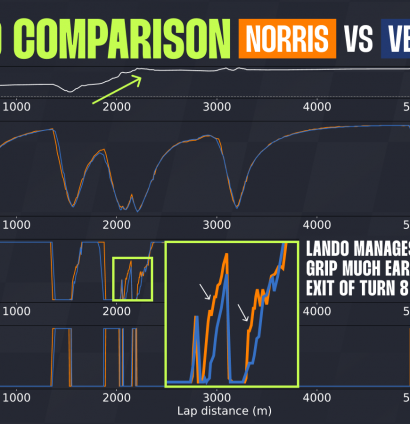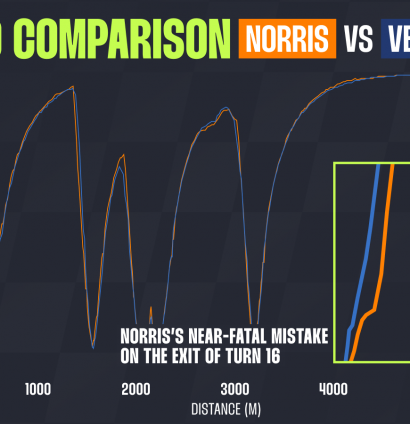How Lando Norris got away with a big mistake on Las Vegas GP pole lap

Lando Norris built up such an advantage in the first half of his pole lap that he got away with a big mistake
After what was arguably the most demanding qualifying session of the F1 2025 season, McLaren driver Lando Norris managed to claim yet another pole position, his third in a row, as his march towards the world championship continues.
How did he do it? And why couldn’t his teammate Oscar Piastri manage better than P5? Telemetry data gives us the answers.
Lando Norris on the brink of the F1 2025 title after Las Vegas Grand Prix pole
Unusually for this circuit, the start of qualifying at the Las Vegas Grand Prix began in dramatic fashion, with heavy rain and large amounts of standing water on track.
Full wet tyres were used for the first time in a long while and drivers struggled not only for grip but also for clean track position during the opening 18 minutes of running.
Visibility was particularly poor, forcing drivers to find creative ways to place themselves in clean air and avoid spray from cars ahead in order to set a representative lap time.
Fortunately, the rain eased and the circuit gradually began to dry through Q2 and Q3.
Lando Norris vs Oscar Piastri: McLaren head-to-head scores for F1 2025
👉 F1 2025: Head-to-head qualifying statistics between team-mates
👉 F1 2025: Head-to-head race statistics between team-mates
What makes conditions like this especially challenging – particularly on a long track such as Las Vegas – is that in Q2 and Q3 there’s simply no time for a pit stop.
Drivers must remain out for the entire session, carrying a full fuel load, which can make the early laps difficult. Teams also had to judge the track conditions carefully beforehand to select the right tyres.
In this case, there was little variation – all drivers who reached Q3 went out on intermediate tyres.
After Piastri had spent much of the first half of Q3 at the top of the timing screens, Norris ultimately snatched his third consecutive pole position with a superb final lap, ahead of Verstappen and Carlos Sainz in P2 and P3 respectively.
When comparing the laps of Norris and Verstappen, we can see that the Briton held a huge advantage all the way up to Turn 16 – where he nearly lost it all.
Norris built his advantage right from the opening corners, thanks to a much stronger run through Turns 2 and 3.
Although Verstappen was tidier through this section, the data shows how Norris managed to extract better traction on the exit of Turn 2, gaining almost half a second in that small section alone.

The next key moment of the qualifying came after the first DRS zone – on the exit of Turn 5, one of the most demanding corners on the circuit.
Norris once again extended his lead, this time due to a mistake from Verstappen, whose rear tyres broke traction momentarily under throttle.
That error cost the reigning champion momentum and allowed Norris to significantly increase the delta in the following corners.
Through Turns 8 and 9, Norris again managed to find greater grip on corner exit, as seen on the telemetry graph below.
You can clearly notice how much earlier he was able to get back on the throttle and extract traction from the intermediate tyres.

By the time he reached the short straight after Turn 9, his advantage over Verstappen was nearly a full second – a lead he maintained until the final slow corners of the lap.
Under braking for Turn 14 – probably the trickiest part of the circuit in these conditions – both drivers were precise and error-free.
However, Norris, perhaps due to greater confidence in his car (which was certainly justified), momentarily lost control of the rear end on the exit of Turn 16, suffering a big oversteer moment.
Luckily for him, a quick steering correction helped him recover grip and return to the racing line.
The incident cost him roughly six tenths of a second – a loss that could have been much more damaging had it not been for his phenomenal first and second sectors.

Despite the late scare, Lando secured pole position – and, more importantly, extended his advantage over his teammate, who ended up only fifth.
So what happened to Piastri?
Once again, the Australian’s weekend didn’t start the way he wanted – though this time, it wasn’t due to his own mistake.
After setting strong laps early in Q3, his final attempt was ruined by a yellow flag caused by Charles Leclerc’s error at Turn 12.
In fact, Piastri was the only driver directly affected as he was running immediately behind the Ferrari.
Telemetry shows that in the first sector of that lap, Piastri was about 0.4 seconds slower than Norris.
That gap stemmed from a small oversteer moment on the exit of Turn 4, where he was forced to briefly lift off the throttle.
However, considering Norris’s much bigger mistake at the end of his lap, had it not been for the yellow flag, Piastri would almost certainly have been in contention for pole.

The silver lining for Piastri is that the Las Vegas circuit offers overtaking opportunities.
Across the previous two grands prix here, we’ve seen nearly 80 per cent more overtakes than the season average.
What remains unknown – both for Piastri and the rest of the grid – is the race pace and the potential strategies.
Due to the disrupted FP2 session, no driver managed to collect meaningful long-run data.
As always on a street circuit, where every mistake can prove costly, unpredictability reigns – and the only certain thing is that nothing is certain.
Read next: Winners and losers from the 2025 Las Vegas Grand Prix qualifying





